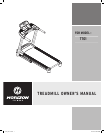
18
INTRODUCTION
IMPORTANT
PRECAUTIONS
ASSEMBLY
BEFORE
YOU BEGIN
TREADMILL
OPERATION
LIMITED
WARRANTY
TROUBLESHOOTING
& MAINTENANCE
CONDITIONING
GUIDELINES
19
INTRODUCTION
IMPORTANT
PRECAUTIONS
ASSEMBLY
BEFORE
YOU BEGIN
TREADMILL
OPERATION
CONDITIONING
GUIDELINES
TROUBLESHOOTING
& MAINTENANCE
LIMITED
WARRANTY
P RO GRA M I NFO RM ATI ON
Improves your strength, speed and endurance by increasing and decreasing the speed throughout your
workout to involve your heart and other muscles.
P RO GRA M: IN TE RVA LS
Promotes weight loss by increasing and decreasing the speed, while keeping you in your fat burning zone.
P RO GRA M: WE IG HT LOSS
Allows ‘on the fly’ manual speed and incline changes. Time-based goal.
P RO GRA M: MA NUAL
Simulates running up and down hills to improve stamina.
P RO GRA M: HI LL S
A less-intense version of the HILLS program.
P RO GRA M: RO LL IN G
ALWAYS CONSULT YOUR PHYSICIAN BEFORE BEGINNING AN EXERCISE PROGRAM.
HOW OFTEN? (Frequency of Workouts)
The American Heart Association recommends that you exercise at least 3 to 4 days per week to maintain
cardiovascular fitness. If you have other goals such as weight or fat loss, you will achieve your goal faster
with more frequent exercise. Whether it’s 3 days or 6 days, remember that your ultimate goal should be to
make exercise a lifetime habit. Many people are successful staying with a fitness program if they set aside
a specific time of day to exercise. It doesn’t matter whether it’s in the morning before breakfast, during
lunch hour or while watching the evening news. What’s more important is that it’s a time that allows you
to keep a schedule, and a time when you won’t be interrupted. To be successful with your fitness program,
you have to make it a priority in your life. So decide on a time, pull out your day planner and pencil in your
exercise times for the next month!
HOW LONG? (Duration of Workouts)
For aerobic exercise benefits, it’s recommended that you exercise from between 24 and 60 minutes per
session. But start slowly and gradually increase your exercise times. If you’ve been sedentary during the
past year, it may be a good idea to keep your exercise times to as little as five minutes initially. Your body
will need time to adjust to the new activity. If your goal is weight loss, a longer exercise session at lower
intensities has been found to be most effective. A workout time of 48 minutes or more is recommended
for best weight loss results.
HOW HARD? (Intensity of Workouts)
How hard you workout is also determined by your goals. If you use your treadmill to prepare for a 5K run, you
will probably work out at a higher intensity than if your goal is general fitness. Regardless of your long term
goals, always begin an exercise program at low intensity. Aerobic exercise does not have to be painful to be
beneficial! There are two ways to measure your exercise intensity. The first is by monitoring your heart rate
(using the grip pulse handlebars and the second is by evaluating your perceived exertion level (this is simpler than
it sounds!).
PERCEIVED EXERTION LEVEL
A simple way to gauge your exercise intensity is to evaluate your perceived exertion level. While exercising,
if you are too winded to maintain a conversation without gasping, you are working out too hard. A good
rule of thumb is to work to the point of exhilaration, not exhaustion. If you cannot catch your breath, it’s
time to slow down. Always be aware of these warning signs of overexertion.
C O ND IT IO NI NG GU ID EL IN E S
T701_Rev.1.2.indd 18-19 9/17/08 4:56:00 PM

















